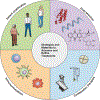Smart cancer nanomedicine
- PMID: 31695150
- PMCID: PMC7227032
- DOI: 10.1038/s41565-019-0567-y
Smart cancer nanomedicine
Abstract
Nanomedicines are extensively employed in cancer therapy. We here propose four strategic directions to improve nanomedicine translation and exploitation. (1) Patient stratification has become common practice in oncology drug development. Accordingly, probes and protocols for patient stratification are urgently needed in cancer nanomedicine, to identify individuals suitable for inclusion in clinical trials. (2) Rational drug selection is crucial for clinical and commercial success. Opportunistic choices based on drug availability should be replaced by investments in modular (pro)drug and nanocarrier design. (3) Combination therapies are the mainstay of clinical cancer care. Nanomedicines synergize with pharmacological and physical co-treatments, and should be increasingly integrated in multimodal combination therapy regimens. (4) Immunotherapy is revolutionizing the treatment of cancer. Nanomedicines can modulate the behaviour of myeloid and lymphoid cells, thereby empowering anticancer immunity and immunotherapy efficacy. Alone and especially together, these four directions will fuel and foster the development of successful cancer nanomedicine therapies.
Conflict of interest statement
Financial and Non-Financial Competing Interest statement
The authors have no financial and non-financial competing interests to declare.
Figures





References
Publication types
MeSH terms
Substances
Grants and funding
LinkOut - more resources
Full Text Sources
Other Literature Sources

